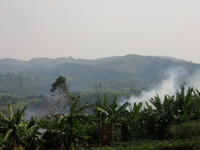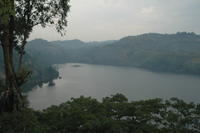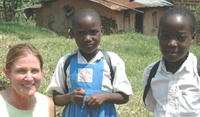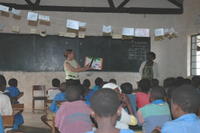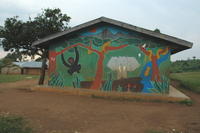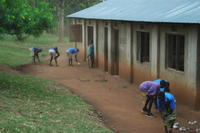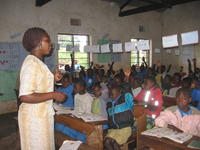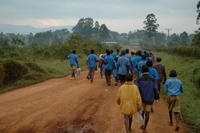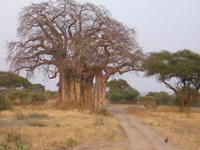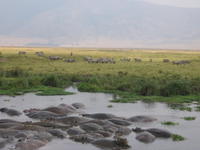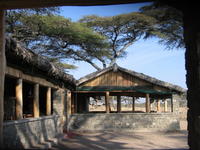We’re learning as fast as we can about Africa, her people, geography, history, culture, educational systems, Swahili, music. Here are three playlists of favorites.
March 2005 (Take 2)
Music from Kenya, Uganda and Tanzania, who are considering federating.
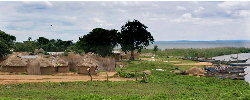
Tabu Ley Rochereau (Congo DRC, Kenya) –
MuzinaFrom a founder and master of pan-African pop, a prayer in the name of the Father (Tata), the Son (Mwana), and the Holy Spirit (Mpeve Santu)
Ayub Ogada (Kenya) –
ChiroOgada is of the Luo tribe of northwest Kenya. This song is an old man’s advice: “See the world but never forget where you came from.”
Samite (Uganda) –
Tunula EnoSamite now lives in upstate New York. Based on a traditional Ugandan song, this is Samite’s tribute to his deceased wife: for each bird in this world is another that loves it.
Tabu Ley Rochereau (Congo DRC, Kenya) –
Nairobi“Harambe”, “together” in Swahili, refers to Jomo Kenyatta’s program in the 1970s and 80s to foster mutual work and progress. The response “Nyayo” means footsteps, as in “we will follow in your footsteps to continue our work together”.
Orchestra Makassy (Tanzania) –
Nakolela CherieLike Tabu Ley, Makassy has roots in Zaire / Congo DRC. In this song a man pleads for his wife to come back and take care of their children.
Samite (Uganda) –
MwatuAbout wooing a woman by promising to provide for her – be it meat she wants, or only vegetables and tofu.
Ayub Ogada (Kenya) –
OndiekAbout a hyena in human form – beware of some among us!
Tabu Ley Rochereau (Congo DRC, Kenya) –
Sala Noki Pascal“Get a move on, Pascal!” What Tabu’s fiancée Georgina told him in 1961. They married soon after. The familiar Caribbean rhythm comes originally from Africa, of course.
Bernard Kabanda (Uganda) –
NnankyaKabanda is master of the Kampala musical style called “just a small guitar”. Nnankya got him drunk and stole his money, but oh she is so beautiful!
Samite (Uganda) –
NdereA love charm.
June 2005
Music from South Africa, Zimbabwe and Madagascar.

Vusi Mahlasela (South Africa) –
When You Come Back
From the soundtrack for the excellent movie
Amandla! – Power!, a revolution in four-part harmony – about South Africa’s freedom struggles. Vusi is known as “The Voice”. I wish he always sang as purely as here.
Oliver Mtukudzi (Zimbabwe) –
Ndima NdapedzaFrom the master also known as “Tuku”. Bonnie Raitt’s song Help Me Lord came from him. In this song a Shona farmer exhorts his community to cultivate their fields as well as he has – and as well as Tuku has his.
Church of Christ Choir (South Africa) –
NgangiboshiweA Zulu choir. What does the song title mean?
Miriam Makeba (South Africa) –
Beware VerwoerdAlso from
Amandla! (see above under Vusi). The renowned Makeba warns Hendrick Verwoerd, former prime minister and architect of apartheid, that resistance will emerge and never end. A classic song from the period.
Lucky Dube (South Africa) –
Crazy WorldGreat reggae, especially on his early albums.
Sibongile Khumalo (South Africa) –
Thula MamaA lullaby: Don’t cry, baby, your mother is coming home soon.
Oliver Mtukudzi (Zimbabwe) –
Wongororo“Take time to think … take it easy on the drums, my girl, the night is still young … it is wise to be steady.”
Rossy (Madagascar) –
MidonaFrom the soundtrack to a PBS special about Madagascar’s plant and animal life.
Oliver Mtukudzi (Zimbabwe) –
Mai VarambaA mother tries to keep her son back from throwing himself into the cruel world, but he has to in order to become a man and to provide for a family.
Lucky Dube (South Africa) –
Khululeka“Khululeka” is Zulu for “to be free”. From a live concert available in whole on CD.
July 2005A mix from across Africa, but mostly from the west and north.
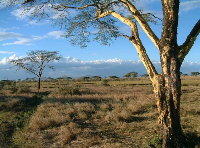
Habib Koite (Mali) –
ImadaWhat an opening! The memory of a love from secondary school, still poignant after 20 years of separation.
Rokia Traore (Mali) –
M’Bifo“Thank you, my love, for being at my side no matter what. … Now I am strong.”
Alpha YaYa Diallo – African Guitar Summit (Guinea) –
Cette Vie“This life, sometimes sad, sometimes happy. What is going to happen?”
Habib Koite (Mali) –
Sarayama“Malian woman, charming woman. … Thank you for being the pillar of the family.”
Cesaria Evora (Cape Verde Islands) –
VelocidadeThe legend sings in Portuguese of an extravagant, mischievous, hip-swinging woman whom the street has nicknamed Speed.
Pa Joe – African Guitar Summit (Ghana) –
Obaa Ya EwaYoung woman, your roaming is not good for you. Come home, come home to me.
Habib Kiote (Mali) –
WassiyeIf you have a daughter who is like your wife, you are doubly blessed.
Oliver Mtukudzi (Zimbabwe) –
RirongereA compendium of Shona proverbs that say in sum, plan, plan for tomorrow!
Danone O’Sow (Ivory Coast) –
TeseguA lullaby: Sleep, my dear. You are close to my heart.
Vusi Mahlasela (South Africa) –
MayibuyeMayibuye: let it return. From the soundtrack for
Amandla! (see the previous playlist above).
 This blog is presented below, on one large web page, in reverse chronological order. Here is a table of contents in the actual chronological order, with brief descriptions and links to a separate page for each entry. You can click any image to see a larger version of it.
This blog is presented below, on one large web page, in reverse chronological order. Here is a table of contents in the actual chronological order, with brief descriptions and links to a separate page for each entry. You can click any image to see a larger version of it.